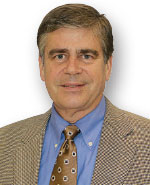The turf wave

Karl Danneberger, Ph.D.
The audience “wave” has been common at sporting events in the United States for decades. It’s believed the wave was first done at National Hockey League games in the late 1970s/early 1980s, but the first video evidence occurred at an Oakland A’s home baseball game in 1981. The wave occurs as one stadium section rises and then sits while the fans in the adjacent section rise. In a closed stadium, the wave starts in one section and ends up back where it started, and the process repeats itself.
The wave also occurs in turf. It’s not that turfgrass plants start a wave on your course. Looking in a more global context, you can see the traits of the wave in turf. For example, the turf disease leaf spot/melting-out occurs in a wave as it occurs from south to north in the United States.
Beginning in January and starting in south Florida, leaf spot of bermudagrass commonly occurs on greens. Not limited to bermudagrass, the disease can occur on seashore paspalum and other warm-season turfgrasses. Informally, the disease was named Heminthosporium leaf, crown and root disease. However, with the pathogen being classified in the genus Bipolaris, Helminthosporium has been dropped. Specifically for bermudagrass, the pathogen associated with leaf spot disease is Bipolaris cynodontis.
The leaf spotting occurs under cool, wet or humid conditions. As winter progresses, the disease appears further north as temperatures become favorable for pathogen infection. As spring arrives and cool-season turfgrasses emerge from winter dormancy and begin active growth, the melting-out disease occurs. The melting-out pathogen on Kentucky bluegrass is Drechslera poae. The lesions appear initially as small purple-colored dots. These lesions turn a gray-to-tan color with a dark purple-to-brown border. In the leaf spotting stage, these diseases don’t normally cause significant injury to the plant.
As temperatures increase, infection can occur in the crown, stems and roots, eventually causing the plants to turn a straw color and die. A similar event occurs in warm-season turfgrasses when temperatures increase; Bipolaris infects crown, stem and roots.
As summertime temperatures arrive and the leaf/crown/root disease progresses on cool-season turfgrasses, conditions favorable for the warm-season version decreases. Like the wave, the Bipolaris cynodontis is sitting down while the Drechslera species and similar species (ex. Bipolaris sorokiniana) are standing up. With the arrival of cold temperatures in the North, Drechslera species “sit down” while temperatures and humidity levels in south Florida during late December are favorable to initiate leaf spot once again.
So, how to stop the wave? With the human wave, many professional players, especially at baseball games, have tried to stop it by telling fans it’s just not cool anymore. Turfgrass pests don’t listen well. So, how do we break the chain of leaf-spotting diseases?
We do it through genetic, cultural and chemical programs. The biggest improvement in Kentucky bluegrass occurred when leaf-spot resistance was found and incorporated into Kentucky bluegrass. These resistant cultivars were the basis for the term “improved” Kentucky bluegrass cultivars. Cultural practices for both cool- and warm-season turfgrasses that help reduce the disease severity include moderate nitrogen fertilization (which promotes growth but doesn’t overstimulate); thatch control; being careful or aware that herbicide applications during active disease times may enhance disease; and enhancing sunlight to the turf. Chemically, there are several fungicides to control melting-out/leaf spot diseases. The most effective applications are applied at the initiation of pathogen infection.
Although I focused on leaf spot, a number of examples could fit the wave pattern. Crabgrass germination is one. Crabgrass germination follows the line of warming soil temperatures (~57 degrees F) moving north in the spring. Another is dollar spot.
I have found one of the coolest things about being in the golf course business and managing turfgrasses is the symmetry and rhythm of living organisms, which you find only if you look.








